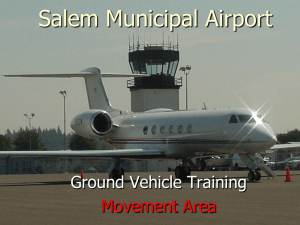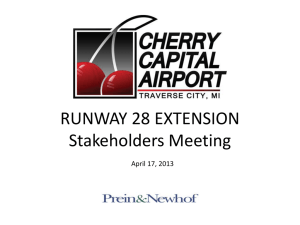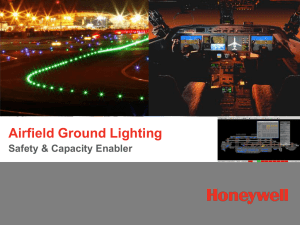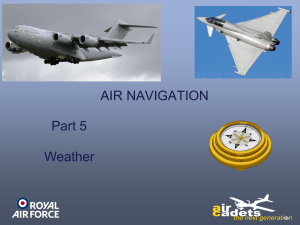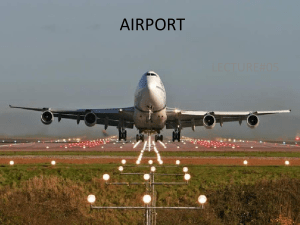laldri~6
advertisement
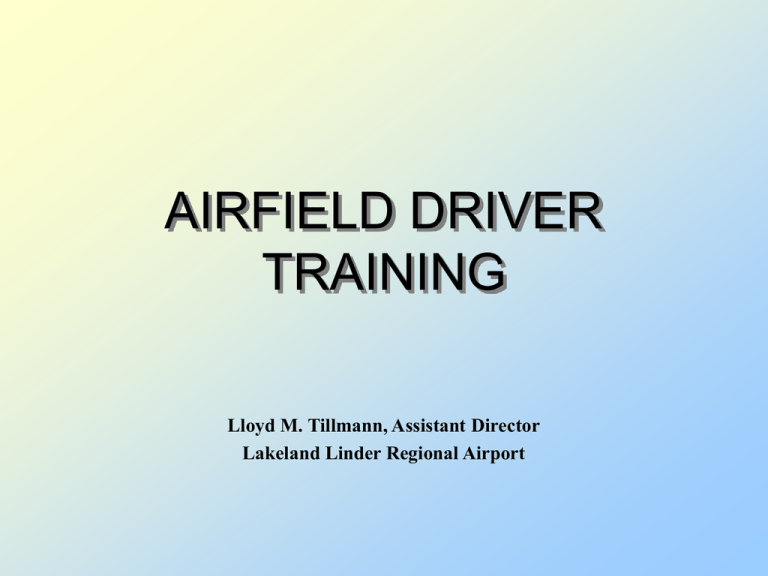
AIRFIELD DRIVER TRAINING Lloyd M. Tillmann, Assistant Director Lakeland Linder Regional Airport Why Driver Training? Standardized Airfield Driver Training Program • • • • • • • • • • Overview/Purpose Airfield Markings Airfield Lighting Airfield Signage Radio Communication Light Gun Signals Runway Incursions Construction Conclusion Acronyms Purpose of Training • To establish a standardized airfield driver training program and make airport operators and vehicle operators aware of the resources available, to maintain the highest possible level of safety within the airport environment. To ensure that the number of runway incursions is reduced, along with the potential for aircraft incidents or accidents. Definitions • Runway – A defined rectangular surface on an airport prepared or suitable for the landing or take off of aircraft. • Taxiway – A defined path established for the taxiing of aircraft from one part of an airport to another. • Movement Area – Runways, taxiways, and other areas of an airport which are used for taxiing, or hover taxiing, air taxiing, takeoff, and landing of aircraft, exclusive of loading ramps and aircraft parking areas. • Please consult your handbook for a detailed list of definitions. Definitions • Runway Incursion – Any occurrence at an airport involving an: • • • • aircraft vehicle person or object on the ground that creates a collision hazard or results in a loss of separation with an aircraft taking off, landing, intending to take off, or intending to land. Rules & Regulations • Federal Aviation Regulation Part 139.329(e) states that a certificate holder shall “ensure that each employee, tenant, or contractor who operates a ground vehicle on any portion of the airport which has access to the movement area is familiar and complies with the airport’s rules and procedures for the operation of ground vehicles”. Vehicle Driving Rules • AIRCRAFT SHALL HAVE THE RIGHT OF WAY OVER ALL VEHICLES. • No person operating a vehicle on the Airport shall fail to observe the directions of posted signs or Air Traffic Control. • Only vehicles with an operational need may drive on the movement area of the airport. Runways and taxiways should not be used as a throughway. • No vehicle shall enter a movement area without prior clearance from Air Traffic Control Tower. • Drivers operating on the movement areas shall be in continuous two-way communications with Air Traffic Control. Vehicle Requirements • Personal vehicles are not permitted on the movement area, unless used in conjunction of business purposes. • Vehicles operating on the movement area shall display a company name and/or logo. • Must have an operating yellow rotating beacon or strobe light. • Sunset to sunrise shall have headlights and taillights. • Equipped with a two-way radio, and must be in continuous communication with the Control Tower. • All vehicles must meet the minimum insurance coverage stipulations as required by Airport Administration. • The use of any unsafe or malfunctioning vehicles/ground equipment is unauthorized. Speed Limits Speeds, at all times, shall be no greater than is reasonable and prudent under existing traffic, safety, and weather conditions. Speed limit on the AOA is 15 miles per hour (mph). Speed limit within the wingtip radius of aircraft is 5 mph. Speed limit of airport perimeter roads is 25 mph. General Safety Rules Violations Airport Administration personnel are authorized to cite violations on any violation of Airport Rules and Regulations. Penalties for such violations are as follows: 1st Violation - Driver’s Primary Tenant will be subject to a $100.00 fine, and driver’s privileges revoked until he/she successfully re-completes the Driver Training Course. Violations, con’t 2nd Violation - Driver’s Primary Tenant will be subject to a $200.00 fine. Driver will receive a 30-day suspension of privileges, and the driver must successfully re-complete the Driver Training Course. Note: Fine for second violation is imposed on Primary Tenant whether violation is committed by same employee who committed previous violation or another employee. 3rd Violation - Driver’s Primary Tenant will be subject to a $500.00 fine. Driver will receive a one-year suspension of privileges, and driver must successfully re-complete the Driver Training Course. Note: Fine for third violation is imposed on Primary Tenant whether violation is committed by same employee who committed previous violation(s) or another employee. Violations, con’t 4th Violation - Driver’s Primary Tenant will be subject to a $1,000.00 fine, and Driver’s privileges will be suspended indefinitely. Note: Fine for fourth violation is imposed on Primary Tenant whether violation is committed by same employee who committed previous violation(s) or another employee. If a violation is received, the Primary Tenant that granted privileges to drive on the Movement Area must issue the payment covering stated fine. The airport will not accept payment in any form other than from the Primary Tenant. Movement Area Airfield Markings • • • • • • • Hold Bars ILS Hold Bars Movement/Non-Movement Area Boundary Surface Painted Holding Position Surface Painted Location Taxiway Edge (Full and Dashed) Vehicle Roadways Hold Bars • Identifies the location where a pilot or vehicle is to stop when clearance has not been granted onto a runway. • Never cross without permission. Hold This • Hold on the solid line side. Side • Used in conjunction with hold position sign(s). ILS Hold Bar • To identify the location where a pilot or vehicle is to stop when he/she does not have clearance to enter the ILS/MLS area. • Located at the perimeter of the ILS/MLS critical area. • Unauthorized penetration could disrupt NAVAIDS. • Used in conjunction with an ILS critical area sign. Movement/Non-Movement Area Boundary Hold This Side • Defines the boundary of the movement area and non-movement area. • Must have permission from ATC to enter movement area. • Hold on the solid line side. Surface Painted Holding Position • Used where pilots had difficulty discerning the location of the holding position and to supplement signs located at holding positions. • Required where the width of holding position on the taxiway is greater than 200’. • Used in conjunction with the hold bar, and sign(s). Taxiway Edge Stripes • Used to delineate the edge of a taxiway, primarily when the edge of the useable taxiway does not correspond to the edge of the pavement. (Example, taxiway shoulders). • Continuous – Paved surface other than full strength taxiway not intended for use by aircraft. • Dashed – Operational need to identify taxiway edge where abutting paved surface is intended for use by aircraft. Vehicle Roadway Markings • Defines route that vehicles should use when the same area is used in conjunction with aircraft. • Markings can be solid or zipper style for greater visibility. • Vehicles should use these routes to the greatest extent practicable. Airport Lighting • Runway Lighting • Taxiway Lighting • Runway End Lights Runway Edge Lighting • Designed to identify the edge of the usable runway surface at night and during periods of low visibility. • Clear (or white) except the last 2000’ of a precision or non-precision instrument runway, lights are amber. Taxiway Edge Lighting • Designed to identify the edge of the usable taxiway surface at night and during periods of low visibility. • Taxiway edge lighting is blue. Runway End Lights • Used to depict the end of the useable runway to aircraft. • Arranged in two sets of four lights. Airfield Signs • • • • • • • • • Hold Position Signs ILS/MLS Critical Area Signs Runway Approach Signs Taxiway Location Signs Distance Remaining Signs No Entry Taxiway Ending Marker Inbound Destination Signs Array of Multiple Signs Hold Position Signs • Used to denote the entrance to a runway or critical area, in conjunction with hold bars. • Have white inscriptions with red backgrounds. • Must not be passed unless permission is granted by ATC. • Should be NOTAMed when unavailable or unlit. ILS Critical Area Sign • Used in conjunction with ILS/MLS Critical area hold markings to identify the outer boundary of the critical area. • White inscription with Red background. • Penetration into area without permission could disrupt NAVAIDs. Taxiway Location Signs • Identify the taxiway on which the aircraft or vehicle is located. • The inscription is yellow with a black background. • Can also be used to designate a runway in which an aircraft or vehicle is located. Distance Remaining Signs • Used to identify the distance remaining on a runway, during take off and landing. • White inscription with black background. • Located at 1000’ increments. No Entry Signs • Indicates that entry into a particular area is prohibited to aircraft. • White dash and circle with red background. Taxiway Ending Marker • Used to indicate that a taxiway does not continue. • Retro-reflective sign or barriers with alternating yellow and black angled stripes. Inbound Destination Sign • Used to designate a location on the airport such as an FBO, ramp parking area, military operation, or fuel. • Black inscription with yellow background. • Denotes generally non-movement area facilities. Radio Communication • • • • • Ground Control Tower Control/CTAF Phonetic Alphabet Proper Phraseology Light Gun Signals Ground Control Frequency • Responsible for the control of aircraft, vehicles, and pedestrians on controlled airport surfaces, except runways. (Movement Areas) • The Ground Control frequency for this airport is 121.40 MHZ. Tower Frequency/CTAF • Controls the movement of aircraft on runways and airport airspace. • Local controller has jurisdiction over runways. • The tower frequency for this airport is 124.50 MHZ. CTAF Common Traffic Advisory Frequency • Movement of aircraft & vehicles on runways and airport airspace when tower is closed. • Driver self announces intentions/movements . • The CTAF frequency for this airport is 124.50 MHZ. • Announce using “Lakeland Traffic…” Phonetic Alphabet A- Alpha B- Bravo C- Charlie D- Delta E- Echo F- Foxtrot G-Golf H-Hotel I - India J- Juliet K-Kilo L- Lima M-Mike N- November O-Oscar P- Papa Q-Quebec R- Romeo S- Sierra T- Tango U- Uniform V- Victor W-Whiskey X- X-ray Y- Yankee Z- Zulu Proper Phraseology • • • • Listen before you transmit. Think about what you want to say. Avoid using slang (no “CB” radio, no police “10” codes) Use aviation related phraseology. • • • • • Roger (I understand) Wilco (Will comply) Acknowledge Affirmative (Yes) Negative (No) Proper Phraseology • Identify who you are calling/name of facility. Vehicle – “LAL Ground… Tenant 1”. Proper Phraseology • Identify who you are calling/name of facility. Vehicle – “LAL Ground… Tenant 1”. • Wait for a response. Tower – “Tenant 1 .. LAL Ground.” Proper Phraseology • Identify who you are calling/name of facility. Vehicle – “LAL Ground… Tenant 1”. • Wait for a response. Tower – “Tenant 1 .. LAL Ground.” • Identify your intentions. Vehicle – “Tenant 1 on the terminal Ramp and would like to cross Runway 9 to the South Ramp”. Proper Phraseology • Identify who you are calling/name of facility. Vehicle – “LAL Ground… Tenant 1”. • Wait for a response. Tower – “Tenant 1 .. LAL Ground.” • Identify your intentions. Vehicle – “Tenant 1 on the terminal Ramp and would like to cross Runway 9 to the South Ramp”. • Wait for a response. Tower – “Tenant 1, Proceed up to and hold short of Runway 9 at Taxiway Bravo.” Proper Phraseology • Identify who you are calling/name of facility. Vehicle – “LAL Ground… Tenant 1”. • Wait for a response. Tower – “Tenant 1 .. LAL Ground.” • Identify your intentions. Vehicle – “Tenant 1 on the terminal Ramp and would like to cross Runway 9 to the South Ramp”. • Wait for a response. Tower – “Tenant 1, Proceed up to and hold short of Runway 9 at Taxiway Bravo.” • Always repeat the instructions back to the tower. Vehicle – “Roger, Tenant 1, Proceed up to and hold short of Runway 9 at Taxiway Bravo.” Light Gun Signals • • • • • • Used when a two way radio system between the air traffic control facility and aircraft or vehicle is unavailable or inoperative. Steady Green Cleared to cross, proceed, or, go. Flashing Green Cleared to taxi (aircraft only). Steady Red Stop. Clear runway or taxiway. Flashing Red Flashing White Return to starting point on airport. Alternating Green/Red Use extreme caution. Runway Incursions • The worst disaster in civil aviation history resulted from a runway incursion (543 dead!). • Runway incursions have increased from 186 to 431 nationally in the last seven (7) years. • Haze and fog increase the risk of runway accidents by a factor of twelve(12). • Runway incursions represent 6% of total aviation fatalities. • 60%-80% of runway incursion result from human error. • Nationally, runway incursions average 1 per every 200,000 aircraft operations. Runway Incursion Data Year 1994 1995 1996 1997 1998 1999 2000 Number of Incursions 200 240 275 292 325 321 431 Runway Incursion Data (cont’d) • Types of Incursions • Operational Error (OE) = 20% of occurrences • Pilot Deviations (PD) = 61% of occurrences • Vehicle/Pedestrian Deviation (V/PD) = 19% of occurrences Ways to Prevent Runway Incursions • See the Big Picture – Watch for aircraft approaching to land or take off. • Transmit Clearly – Make your instructions and read backs complete and easy to understand. • Listen Carefully – Listen to your clearance. Do not let communications become automatic. • Situational Awareness – Know your location. Know what is going on around you, in all directions. • Admit When Help is Needed – Ask ATC for help. Better to damage your pride than property. Ways to Prevent Runway Incursions • Understand Signs, Lights, and Markings – Keep current with airport signs, lights, and markings. Know what they mean and what action to take. • Never Assume – Do not take clearances for granted. Look both ways before entering or crossing taxiways and runways. • Follow Procedures – Establish safe procedures for airport operations. Then follow them. • Right of Way - When giving way to aircraft, ensure personnel and vehicles are outside of the Obstacle Free Area (OFA) Airport Construction • Ensure that contractors are briefed on airport surroundings. • Keep construction areas well guarded and lit. • Establish haul routes away from runways and taxiways. (If possible) • Ensure that NOTAMS are current. • Coordinate construction activities with your air traffic control tower. • Advisory Circular 150-5370-2C provides information. Review • • • • Runways White Markings White or Amber lights Hold Lines Hold Signs Taxiways • Yellow Markings • Blue Lights • Movement Area Lines LAL Airport Layout LAL Non-Movement Areas LAL Movement Areas Conclusion To ensure safe operations are conducted at airports, it takes a cooperative effort from all who are involved. This includes pilots, controllers, airport operators, vehicle operators, and contractors. Together, we can make a difference to reduce incidents and make runway incursions, a thing of the past. Acronyms • • • • • • • ATC – Air Traffic Control FBO – Fixed Based Operator ILS – Instrument Landing System MLS – Microwave Landing System NAVAID – Navigational Aid NOTAM – Notices to Airmen SMGCS (Smigs) – Surface Movement Guidance and Control System
